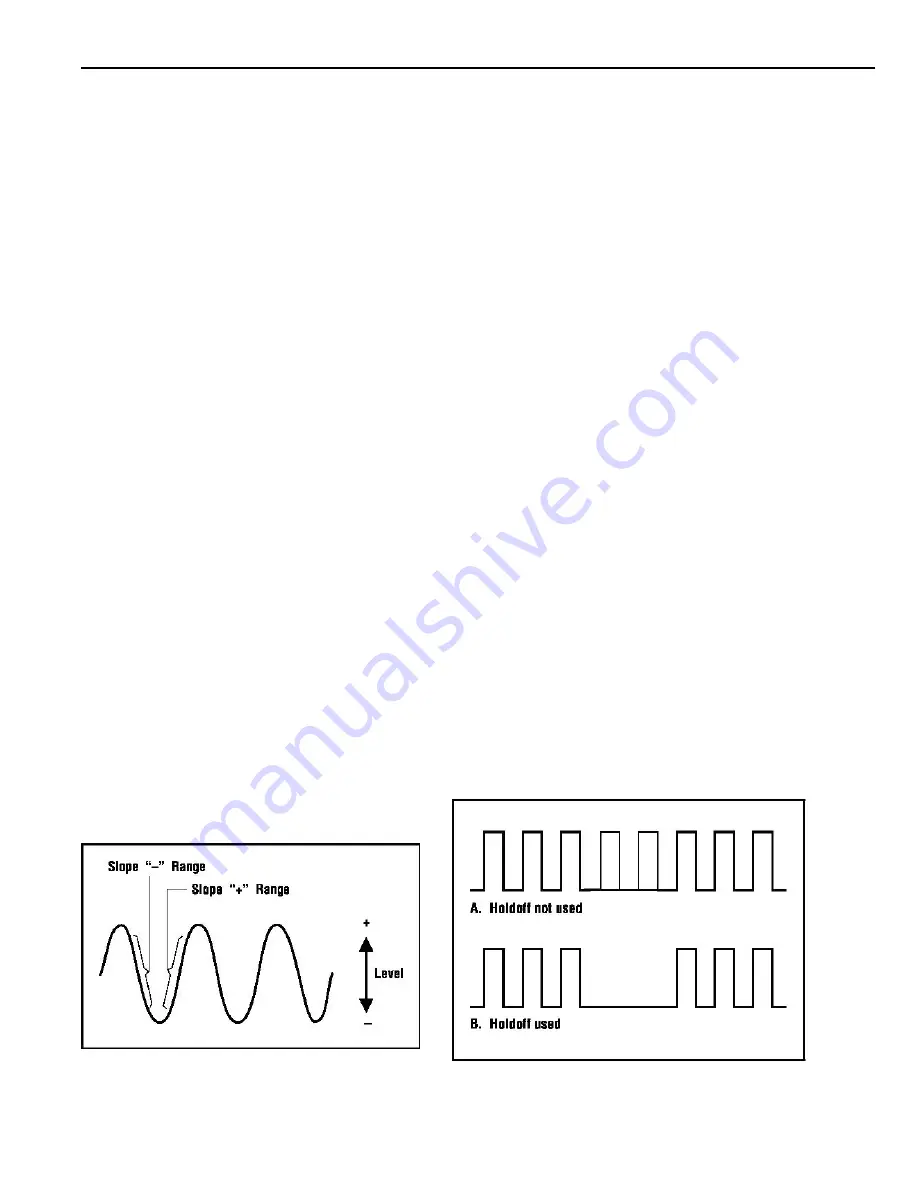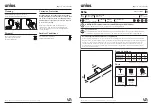
16
mode
(VERT MODE
set to
DUAL),
and with
alternate sweep only
(PULL CHOP
not engaged).
3.
In the
EXT
position, the signal applied to the
EXT
TRIG
jack becomes the trigger source. This signal
must have a timing relationship to the displayed
wave-forms for a synchronized display.
4.
In the
LINE
position of the
COUPLING
switch,
triggering is derived from the input line voltage (5
0/60 Hz) and the trigger
SOURCE
switch is disabled.
This is useful for measurements that are related to
line frequency.
TRIG LEVEL/PULL (–) SLOPE Control
(Refer to Fig. 3)
A sweep trigger is developed when the trigger source
signal crosses a preset threshold level. Rotation of the
TRIG LEVEL
control varies the threshold level. In the
+
direction (clockwise), the triggering threshold shifts to a
more positive value, and in the – direction
(counterclockwise), the triggering threshold shifts to a
more negative value. When the control is centered, the
threshold level is set at the approximate average of the
signal used as the triggering source. Proper adjustment of
this control usually synchronizes the display.
The
TRIG LEVEL
control adjusts the start of the sweep
to almost any desired point on a waveform. On sine wave
signals, the phase at which sweep begins is variable.
Note that if the
TRIG LEVEL
control is rotated toward
its extreme
+
or – setting, no sweep will be developed in
the normal trigger mode because the triggering threshold
exceeds the peak amplitude of the sync signal.
When the
PULL (–) SLOPE
control is set to the
+
(“in”)
position, the sweep is developed from the trigger
source waveform as it crosses a threshold level in a
positive-going direction. When the
PULL (–) SLOPE
control is set to the
– (“out”) position, a sweep trigger is developed from the
trigger source waveform as it crosses the threshold level in
a negative-going direction.
TIME BASE Control
Set the
Time Base TIME/DIV
control to display the desired
number of cycles of the waveform. If there are too many cycles
displayed for good resolution, switch to a faster sweep time. If only a
line is displayed, try a slower sweep time. When the sweep time is
faster than the waveform being observed, only part of it will be
displayed, which may appear as a straight line for a square wave or
pulse waveform.
HOLDOFF Control
(Refer to Fig. 4)
A “holdoff” period occurs immediately after the completion of
each sweep, and is a period during which triggering of the next sweep
is inhibited. The normal holdoff period varies with sweep rate, but is
adequate to assure complete retrace and stabilization before the next
sweep trigger is permitted. The
HOLDOFF
control allows this
period to be extended by a variable amount if desired.
This control is usually set to the
MIN
position (fully
counterclockwise) because no additional holdoff period is necessary.
The
HOLDOFF
control is useful when a complex series of pulses
appear periodically such as in Fig. 4B. Improper sync may produce a
double image as in Fig. 4A. Such a display could be synchronized
with the
VAR SWEEP
control, but this is impractical because time
measurements are then uncalibrated. An alternate method of
synchronizing the display is with the
HOLDOFF
control. The
sweep speed remains the same, but the triggering of the next sweep is
“held off” for the duration selected by the
HOLDOFF
control. Turn
the
HOLDOFF
control clock-wise from the
MIN
position until the
sweep starts at the same point of the waveform each time.
Fig. 3. Function of Slope and Level Controls.
Fig. 4. Use of HOLDOFF Control.











































